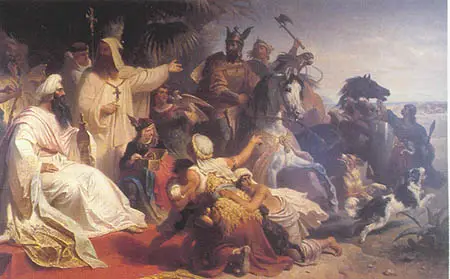Harun Al-Rashid
Harun al-Rashid was the fifth ruler (caliph) of Abbasid dynasty. His reign is considered to be the golden age of Islam. Harun’s rule was a time of cultural, scientific and religious progress. He was very fond of arts and music and patronized artists, calligraphers, architects and musicians. He also established a huge library called ‘House of Wisdom’ in Baghdad, Iraq.
He developed his capital, Baghdad into a modern city that was the center of cultural, scientific and trade activities. Later in 796 AD, he moved his capital to Ar-Raqqah in Syria. The famous Arabic work of literature called ‘Book of One Thousand and One Nights’ carried fictional accounts of his splendid court and personal life.


Early Life: Al-Rashid was born in 763 in Rey, Tehran Province in modern day Iran. He was the son of Al-Mahdi, the third Abbasid Caliph. His mother was a Yemeni slave girl who had qualities of both head and heart. She played an important role in the upbringing of his son. She greatly influenced Harun’s decision making as Caliph till her death in 789 AD.
Harun was brought up with his elder brother Al-Hadi in the court and was tutored by Yahya Barmakid. Barmakid later became his chief minister and advisor. As a young man in his late teens, Harun led military campaigns against Byzantine forces. In a campaign in 782, he reached outskirts of Constantinople and successfully brokered a treaty with Byzantine rulers on terms which were favorable for Muslims.
In recognition of his achievement, his father gave him the title of Al-Rashid (The one who is on right path). Harun was also appointed as governor of Syria, Egypt, Tunisia, Armenia, and Azerbaijan and was promoted as second in line for succession to throne. In 785, Harun’s father died and his elder brother Hadi became Abbasid Caliph. However, in 786 Hadi died under suspicious circumstances and Harun succeeded Hadi on September 14, 786.

Harun’s Reign: Harun’s kingdom was enormous. It stretched from Mediterranean in west to India in the east. He appointed his tutor and advisor, Yahya Barmakid as his chief minister. During the early years of his rule, Yahya and Harun’s mother exercised significant influence on his decision making. In 789, Harun’s mother died and then Yahya was calling the shots till he fell from favor with Harun in 803. Throughout his rule, Harun had to face several rebellions and internal strife.
Revolts took place in Egypt, Syria and other eastern provinces but Harun successfully quelled them. In 803, Harun dismissed Jafar Barmakid, his chief minister and son of Harun’s former mentor and chief minister Yahya. He imprisoned and later executed Jafar and sent his family into exile. Historians believe that Harun was not happy with Barmakid family’s hold and influence on administration and their growing power base. In 796, Harun moved his capital to Ar-Raqqah in Syria and spent 12 years of his rule there.
Towards the later part of his reign, the caliphate started to get weak and number of revolts increased. He had divided his kingdom among his two sons, Al-Amin and Al-Mamun, giving Al-Amin western provinces and Al-Mamun, the eastern provinces.

Later Life and Death: In 808, Harun decided to lead a campaign to quell revolt in Khorasan, Iran. During this journey he fell ill near city of Meshed and had to stay there for several months. It was there that he died on 24 March, 809 at the age of only 46.
He was succeeded by his elder son Al-Amin. Harun’s reign is known for its magnificence and wealth and incredible progress made in the fields of arts, science and culture.




